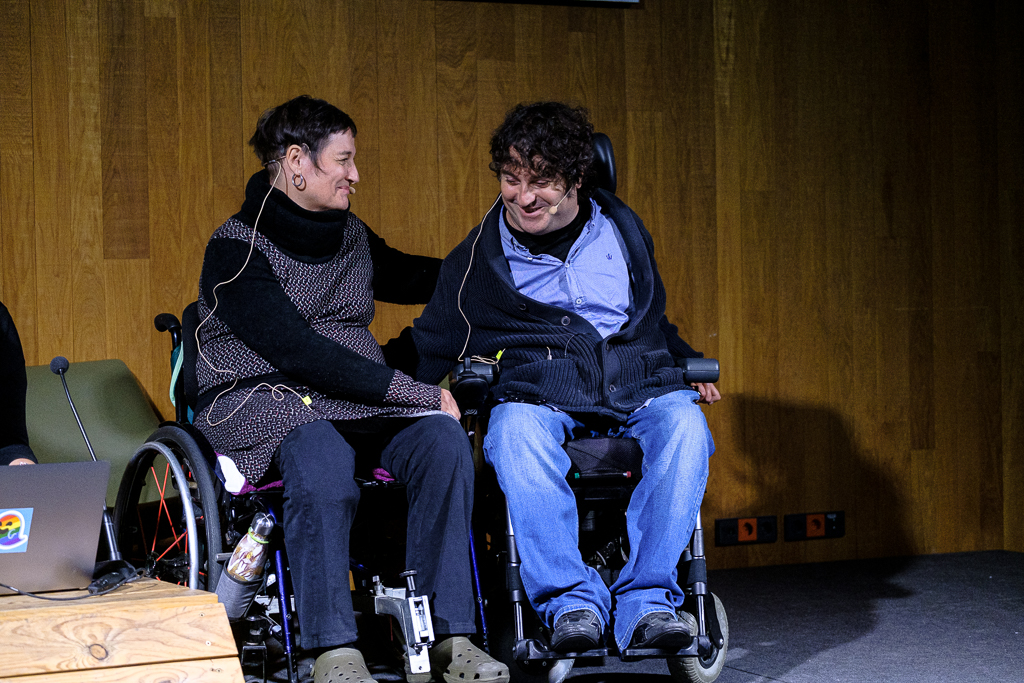"Cultural representation of functional diversity is poor, stereotyped and polarised".

Interview with Diversorium's principals, Antonio Centeno and María Oliver
The soul of a project is the people who implement it, the spirit that brings them together to realise a dream.
In the case of our Barcelona concomitance, Diversorium: Living arts and convivial spaces, These people are the principals, Antonio Centeno and María Oliver, members of the Oficina de Vida Independiente de Barcelona (OVI).
They understand culture not only as a dissemination channel for political discourses and ideologies, but as a real element that stimulates and accelerates change in a society. With the help of our mediator, Veronica Valentini, they work to promote a meeting of all those bodies that want to enrich their reality through exchange and coexistence with others.
María, you define yourself as an “activist since you were 12 years old”, tell us about your long journey.
MARY: The only uncomfortable way to inhabit functional diversity is activism, without it, not only does it become something very sad, but it reduces us to being almost an object. The only way out of everything that this society, which discriminates against us, imposes on us, is activism.
It is also a tool for promoting change.
M: That is for sure, otherwise we would not have achieved what we have achieved. In that sense, activists for functional diversity, and any other kind of activism, deserve all my respect. But when I landed in this world I was not so aware of the importance of this daily struggle, as a vital necessity beyond the achievement of concrete goals, clawing for rights that seem obvious but are not applied.
«From a position of life in which you don't have an apparent functional diversity - and you are useful, you work, you produce for society - you take for granted that people with functional diversity have acquired rights and life is more or less solved, but I realised that it is not like that, everything has to be fought for, to keep working, the pension, the pavements you can climb or the buses you can take».»
The OVI has been working since 2006, Antonio as one of the founders and María joining later. What achievements do you highlight so far?
ANTONIO: We started out as a very small group of nine people and in a very unusual way, the OVI was not a programme created by the administration but we were the ones who organised ourselves. In these fifteen years we have managed to maintain at least what we had, despite the political changes, both in the City Council and in the Social Affairs area of Barcelona.
We have also accumulated knowledge with a study based on the SROI (Social Return on Investment) method, which assesses a service from an economic point of view and concluded that for every euro invested by the Administration in personal assistance, a social return of three euros is achieved. Moreover, we have gone from being a pilot project to a model city, today assistance for independent living is the centre of attention to functional diversity and, around this, many other related services of the Generalitat itself revolve.
Therefore, taking into account the rhythms of the Administration, in these fifteen years we have made a lot of progress, the way the Administration works has changed considerably. But the pace of life is different, there is a very high personal price to pay, it is horrible that we have spent fifteen years of our lives getting out of bed. So there are achievements, but we are very tired.
What challenges are next on the roadmap?
A: Apart from progressing faster than in the last fifteen years, we still need to awaken the desire of people with functional diversity to have a life of their own with personal assistance. This is a slow, interesting, more complex path, which in turn connects us with other types of pathways such as culture, creating a richer and more realistic imaginary of what functional diversity is.
Within this constructed ideology, there is the concept of normality, which you talked about in a speech at the San Sebastian Film Festival.
A: Normality is a strange idea, difficult to define, there is a common structure regarding gender, sexual orientation and identity, ethnicity, language or religion, by which those in power determine what is normal or the same as them.
«In the case of functional diversity, the social mandate that each person must be productive and competitive with respect to others is challenged, we are super useless and it is difficult to defend the right to be useless, all efforts are focused on trying to defend the fact that we are useful in order to try to appear normal. We defend difference as a better way of living and a more realistic way of facing life, trying to manage that reality from homogenisation does not work. Our job is to generate alliances with those who are subjected to this same oppressive scheme and to contribute in another way».»
It is very interesting how you use difference as an element of strength, not segregation.
M: We start from the assumption that living alone, as an individual or as a collective, is not impossible, but absurd. We are social animals, it is banal, but that is how it is. The aim of Diversorium is to make the margin to which we are destined by the power that shapes the idea of normality and excludes you, joyful, by establishing alliances to create a strong front that transforms this imaginary that we carry inside us, almost at the level of our DNA. The only way to make this margin joyful is culture, festivity, the presence of desire, and this has to be summoned, even if it is by almost magical means.
A: It is a complex balance, you need spaces and dynamics of being among equals to become aware, to build a political voice of that reality and to transcend the personal towards something collective. At the same time, this political identity does not serve to build a parallel world, but it must serve to connect us with other realities in order to make politics, so that what is ours is not the same as always, i.e. charity, solidarity, which goes from good to bad.
How does culture help to change this imaginary?
A: We need to change our outlook and values regarding our reality and this comes from direct experience, promoting a model of coexistence that puts an end to ghettos and breaks down stereotypes, something that is going very slowly. In this sense, culture and art not only change reality but also create it, which gives us a great responsibility.
Are there stereotypes that are also fed by culture?
A: The cultural representation of functional diversity is very scarce and, the little that there is, is very biased, stereotyped and polarised. Only the individual who suffers a lot and whose only horizon is practically to commit suicide, such as Ramón Sampedro, is represented, and at the other extreme, there are the very nice, struggling and inspiring people who help normal people not to be so bored in their lives, such as Campeones. Therefore, culture and the media need to build a much richer, realistic, diverse narrative that shows us how it is possible to live independently with functional diversity and that those who have it want to live in this way.
Opting for another cultural representation of functional diversity is also enriching.
A: It is a two-way model, a process in which culture is more than a tool in the service of a particular policy, but can nurture and harness the creative and interesting potential of diversity for its own work.
«The sad thing about these productions is that they only end up being of interest to the collective, this resistance from the public seems to me to be the big issue, that's why we have to keep insisting».»
How does the Diversorium emerge in this context and what do you dream will come out of it?
M: It is difficult to think now about getting together, meeting, sharing a space, but ideally we would find a model that could be replicated in other cities developing their own Diversoriums.
«This project arises from the need to create spaces in which the encounter dissolves created categories and to understand difference not as something problematic, but as something that is part of life and that helps to improve society».»
A: I think there will be a rebound. After all this time of isolation and perceiving the other as a risk, there will be a huge need to return to presence, to share with the other. In a certain sense, this situation could favour the Diversorium, because there will be a lot of “normal” people who will connect better with the idea of coming together and sharing in informal spaces and through the party. The important thing now is to match our project with this moment of rebound. I just remember what happened at the Apollo and it worked without anyone knowing about it, so I hope that, as it becomes known, it will make even more sense and have even better context than before the pandemic.










 Concomitentes
Concomitentes